August/September Update - A bit about the writing

Most of The Gates of Vienna I’ve written by just writing. There might have been a vague outline at times, but more than anything there is just a loads of little, separate bits of dialogue, descriptions and random paragraphs that I’ve been mashing, massaging and chucking about to form the five main Points of View that form The Gates of Vienna. Its okay, but I’ve had a bit of a hard time getting started on what is going to be the first in-app Point of View purchase – Valvasor, AKA Johann Weikhard Freiherr von Valvasor, or Janes Vajkard Valvasor if you’re Slovenian.
Slovenia – this quaint, frustrating and beautiful little country my parents came from – has always been in there somewhere, but I could never really work out how it would figure in The Gates of Vienna. As a young Slovenian child I was fed stories about “The Incursions” and Janissaries stealing righteous Catholic children and brainwashing them into shock troop Janissaries.
I had a conversation a year ago in Ljubljana whilst visiting friends and family with a real life Balkan ethnographer by the name of Božidar Jezernik (see below). We chatted about the book, about the Balkans and Turkey and all that, and then he asks “You know Valvasor was supposed to be at the siege of Vienna?” Sure enough, he then asks me if I’ve ever read anything about any unicorns and the whole thing started in my head.
Just writing sort of worked for a bit, but then I was quickly stuck. So then I thought, maybe I should try some sort of structure.
I’m not one of these guys that likes these sort of “read my 5 quick steps to write a bestseller with my easy to learn formula” guys. I’ve read loads of them and was always wary.
I ran across the story sculpting techniques of a guy called Harold Page. He talks about two things that I decided to try, Conflict Maps and QABN’s. The first is an interesting way of looking at a story, in particular novels where there is typically loads of conflict to keep people reading. The other QABN (Question, Answer…But Now) is a way of mapping out how to make things difficult for your characters or otherwise create the conflict.
Both were useful for just thinking through conflict and tension but I decided to take it a bit further, first doing the Conflict Map to start to see the whole picture and all the forces that could be at work in this characters life and then using the QABN to spell out in better detail the things in his way and then mapping it across time and place. As an added bonus I threw in actions, emotions and tension, which the jury is still out on.
Whilst this is probably overdoing things as this point, its useful in the writing to create a horizon and gives you something to write towards. I would be stupid to assume that I have to follow it like a formula, things change, the dialogue works one way and the way the plot takes you is another. But its very helpful to give you a baseline and something to keep in mind while you’re writing.

